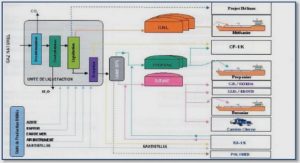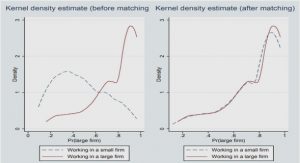Get Complete Project Material File(s) Now! »
Emerging organic contaminants
While the number of known organic chemicals might seem large, the number of potential organic chemicals (those that could possibly be synthesized and those that already exists but which have not been identified) is unimaginably large. [73] The emission of so-called “emerging” or “new” unregulated contaminants [Table 1.4] has become an environmental problem, and there is widespread consensus that this kind of contamination may require legislative intervention. [49] Emerging contaminants are any synthetic or naturally occurring organic chemical(s) or microorganisms that are not commonly monitored but have the potential to enter the aquatic environment and impair the quality of raw water or cause known or suspected adverse human health or ecological effects. This group mainly comprises products used in large quantities in everyday life, such as human and veterinary pharmaceuticals, personal care products, [78] surfactants and surfactant residues, plasticizers,[49] hormones, biocides, polyfluorinated compounds, polychlorinated biphenyl ethers (PCBEs), phosphoric esters and flame retardants and various industrial additives.[75] The characteristic of these contaminants is that they do not need to be persistent in the environment to cause negative effects, since their high transformation and removal rates can be offset by their continuous introduction into the environment. [49]
One of the main sources of emerging contaminants is untreated urban wastewaters and wastewater treatment plant [WWTP] effluents. [Figure 1.3] Current WWTPs are not designed to treat these types of substances and a high portion of emerging compounds and their metabolites. [49] These can escape elimination in WWTPs and enter the aquatic environment via the effluents, leach from WWTP sludge applied to land or solid waste disposal sites and finally find their way into the drinking water value chain. A detailed discussion of these groups will be given later this document. Key challenges for the Drinking Water Industry In order for water utilities to provide safe drinking water for human consumption and use, it is critical that organic contaminants which are potentially hazardous and can impact on the quality of drinking water and the health of consumers be identified. From the preceding discussions, it is evident that a number of analytical techniques that allow successful detection of these compounds have been developed although key analytical challenges still exist as explained in the above section. [75,79] In practice, it is impossible to monitor for hundreds of compounds and the concept of reducing the number of organic contaminants to analyze for in a particular class of organic compounds or mixture of compounds is included in each of the above approaches. This emphasizes the need for the selection and prioritization initiatives. Various selection and prioritization schemes have been developed by various governmental organizations and institutions. [102-105] these are discussed in detail in Chapter 2 of this document. In the absence of such schemes, the use of WHO guidelines for drinking water quality as a benchmark to determine parameters of concern to the drinking water industry including organic variables has been the norm. However, member states are still faced with the challenge of assessing local conditions and selecting those parameters that are relevant for the country or region.
Key challenges for the Drinking Water Industry
In order for water utilities to provide safe drinking water for human consumption and use, it is critical that organic contaminants which are potentially hazardous and can impact on the quality of drinking water and the health of consumers be identified. From the preceding discussions, it is evident that a number of analytical techniques that allow successful detection of these compounds have been developed although key analytical challenges still exist as explained in the above section. [75,79] In practice, it is impossible to monitor for hundreds of compounds and the concept of reducing the number of organic contaminants to analyze for in a particular class of organic compounds or mixture of compounds is included in each of the above approaches. This emphasizes the need for the selection and prioritization initiatives. Various selection and prioritization schemes have been developed by various governmental organizations and institutions. [102-105] these are discussed in detail in Chapter 2 of this document. In the absence of such schemes, the use of WHO guidelines for drinking water quality as a benchmark to determine parameters of concern to the drinking water industry including organic variables has been the norm. However, member states are still faced with the challenge of assessing local conditions and selecting those parameters that are relevant for the country or region.
As a result, there is a need for a generic protocol that will develop a criterion for all relevant classes of organic contaminants in the drinking water value chain. The protocol will describe a prototype procedure for the selection and prioritization of organic contaminants for use by the Drinking Water industry. It will emphasize the system assessment approach from catchment to tap in order to consider all organic contaminants of relevance to the drinking water value chain. Emphasis is made on assessing local conditions and determining the relevant potential environmental stressors and comparison with similar situations elsewhere in order to compile the “pool of organic contaminants” from which to select. The protocol will also contain summarized tailor made water quality monographs for immediate use by water utilities. This will be achieved through the following aims and objectives. However, it should be acknowledged that mixture effects which are usually accounted for using biomonitoring methods will not be accounted for in this study which will be based on chemical analysis and evidence from the literature. Such effects are not within the scope of the current study.
Assessment of the USEPA Approach [Figure 2.2]
The USEPA methodology uses a contaminant pool, the “universe” of potential contaminants for drinking water. [Step I, Figure 2.2] It is indicated in the approach that two hundred and eighty four (284) data sources were used and all chemical agents were targeted including biological, natural occurring and radiological parameters. The resultant “pool of contaminants” had 6000 entries. This data set is too big for this type of exercise especially considering the degree of heterogeneity. It would be difficult to manage given the diversity of physico-chemical properties and mechanism of action for toxicity or respective health effects on target organisms including human beings. It will therefore be difficult to apply common screening criteria to the whole set. This is seen in the way the group uses data sets for different criteria application. The USEPA uses recognized selection and prioritization methods. This is reflected in the model used. [Figure 2.2] This is a positive aspect to note and it could be adopted in the current proposed protocol. Three steps, namely; “identifying the universe” which is synonymous to selecting the “pool of contaminants”, screening to a preliminary contaminant candidate list (PCCL) and finally selecting the CCL which is the equivalent of the prioritization step.
The occurrence, toxicity and human health effects criteria and relevant end points are used to select, screen and prioritize chemicals. Hence, recognized selection and prioritization approaches are used. However, in step three of the method the use of many models is proposed which might hamper the objectivity and reliability of the method. This disadvantage emanates from the management issues mentioned in the preceding section. Many attributes used to select and prioritize contaminants leading to less objectivity of the approach. Use of training data sets for different criteria is proof that the occurrence and health effects attributes were not applied consistently across the same pool of contaminants. [10] This is also observed in the application of different attributes to different data sets. The distribution graphs used to estimate potency might give different potencies for different situations which constitutes a major disadvantage, for example, the distribution of the 10-4 values for cancer risk was skewed with values up to 5 orders of magnitude above the modal value (more potent carcinogens) but only 2 orders of magnitude below the mode (less potent carcinogens) . This particular criterion might be difficult to apply to non-carcinogens.
CHAPTER 1 GENERAL INTRODUCTION
1.1 Background of the study
1.2 Human exposure to organic contaminants in the drinking water value chain
1.3 Sources and pathways of organic contaminants in drinking water value chain
1.4 Fate and behaviour of organic contaminants in the drinking water value chain
1.5 Main categories of organic contaminants of concern
1.6 Assessment of human health impacts
1.7 Overall assessment
1.8 Problem statement
1.9 Aims and objectives
1.10 References
CHAPTER 2 SELECTION AND PRIORITIZATION APPROACHES FOR ORGANIC CONTAMINANTS: A REVIEW
2.1 Introduction
2.2 Selection and prioritization approaches by government agencies and private industries
2.3 Overall assessment of reviewed approaches
2.4 Conclusions
2.5 References
CHAPTER 3 A GENERIC PROTOCOL FOR THE SELECTION AND PRIORITIZATION OF ORGANIC CONTAMINANTS FOR MONITORING IN THE DRINKING WATER VALUE CHAIN
3.1 General introduction
3.2 Specific components of the protocol
3.3 The selection and prioritization approach
3.4 References
CHAPTER 4 THE VALIDATION OF THE SELECTION AND PRIORITIZATION PROTOCOL IN A PROTOTYPE DRINKING WATER VALUE CHAIN: A CASE STUDY OF THE RAND WATER BOARD
4.1 Background
4.2 Application of the protocol
4.3 References
CHAPTER 5 GENERAL DISCUSSIONS AND CONCLUSIONS
5.1 Introduction
5.2 The discussion of the results of the assessment of the components of the protocol
5.3 General conclusions
5.4 References
CHAPTER 6 GENERAL RECOMMENDATIONS
6.1 Introduction
6.2 Disseminating the protocol
6.3 Recommendations on the implementation of the protocol
6.4 Recommendations on capacity building
6.5 Recommendations for testing in environmental samples
6.6 Recommendation for further research
6.7 Recommendations for successful public health protection






